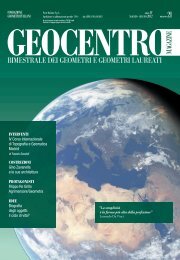Geocentro Magazine - numero 6 - novembre/dicembre 2009
Geocentro Magazine - numero 6 - novembre/dicembre 2009
Geocentro Magazine - numero 6 - novembre/dicembre 2009
You also want an ePaper? Increase the reach of your titles
YUMPU automatically turns print PDFs into web optimized ePapers that Google loves.
http://en.wikipedia.org/wiki/Ecumene<br />
Questo crescente interesse verso l’opera di Tolomeo spinge<br />
Iacopo Angeli da Scarperia, allievo di Crisolora, a realizzare<br />
una versione in latino del codice del maestro, e poi Francesco<br />
Lapaccini e Domenico Boninsegni ad elaborare delle copie<br />
dell’opera con la toponomastica interamente tradotta in<br />
latino per rendere totalmente accessibile la Geographia di<br />
Tolomeo agli studiosi ed ai curiosi del tempo, affrancando<br />
così definitivamente l’opera da quel millenario oblio e<br />
trasformandola in un vero e proprio best seller cartografico.<br />
La Geographia diviene negli anni a seguire un’opera<br />
monumentale, realizzata con materiali di vaglio, spesso<br />
impreziosita con fatture di pregio e raffinate decorazioni in<br />
oro, ed entra a far parte delle biblioteche dei più celebri e<br />
potenti personaggi del tempo, come Palla Strozzi, Lorenzo de’<br />
Medici, Federico da Montefeltro, Alfonso d’Aragona, Borso<br />
d’Este, Papa Gregorio XII, oltre che di <strong>numero</strong>si studiosi ed<br />
eruditi.<br />
La crescente diffusione della Geographia origina quindi una<br />
ricca attività editoriale, che fa di Firenze il primo centro<br />
di produzione di atlanti tolemaici di varie fatture e che si<br />
espande in altre città d’Europa, conducendo alla nascita<br />
di un florido mercato cartografico, anche a fogli sciolti,<br />
Th e fi rst one (chronologically and for its relevance) it’s the<br />
renewed consideration of the Ptolemaic Geography in the<br />
Western Countries. While such a theory had been neglected<br />
for almost a thousand years in Europe, through the Greek<br />
inheritance it had been enriched and continued by the Islamic<br />
culture in the Middle East.<br />
Florence, 1397: this re-discovery begins with the coming into<br />
town of the Byzantine Humanist Emmanuel Chrysoloras.<br />
He had been asked to teach Greek in the famous Studio by<br />
the notorious man of letters and Chancellor of Florentine<br />
Republic, Coluccio Salutati.<br />
Together with Chrysoloras, also a Greek copy of the Geographia<br />
by Ptolemy with all its maps arrived in Italy. It was used, with<br />
others codes belonging to Chrysoloras himself, for the teaching<br />
activity in the Studio.<br />
Th e code was immediately recognised as a cornerstone. Th rough<br />
it, for the fi rst time, the students of the Studio could be able to<br />
see “in pictura” all the places always mentioned in the classics:<br />
nouns of towns, mounts, rivers, countries and peoples.<br />
Th e Florentine Studio acted as a sort of “sound box” for a<br />
wider audience interested in knowing the world through the<br />
sight of Ptolemy. Quite soon, after the academic success, came<br />
Una carta stampata del XV secolo raffi gurante la descrizione di Tolomeo dell’Ecumene (1482, Johannes Schnitzer, incisore)<br />
A printed map from the XV century depicting Ptolemy's description of the Oecumene (1482, Johannes Schnitzer, engraver)<br />
55






